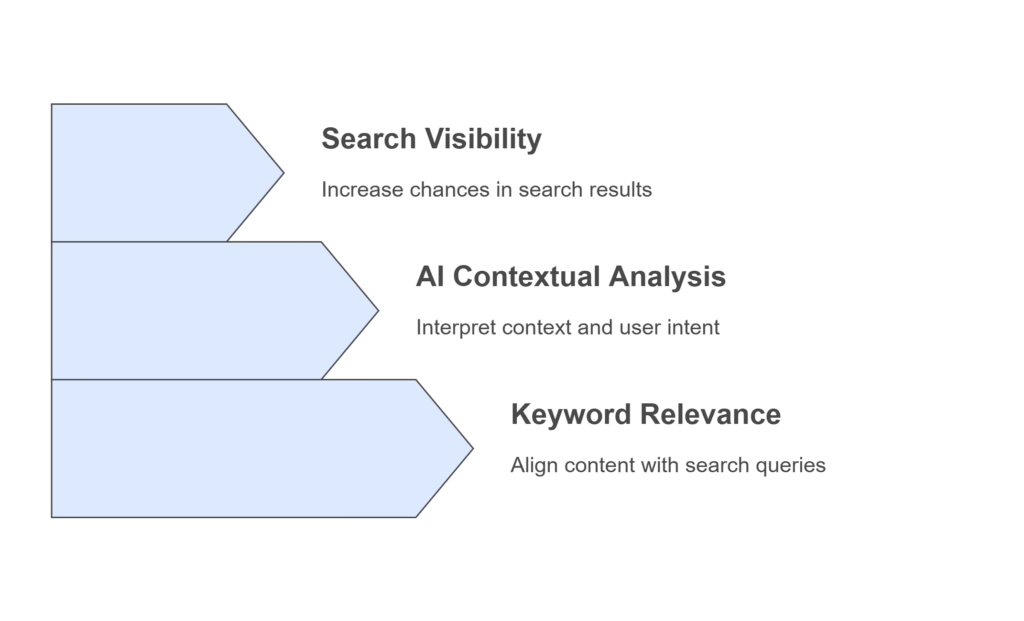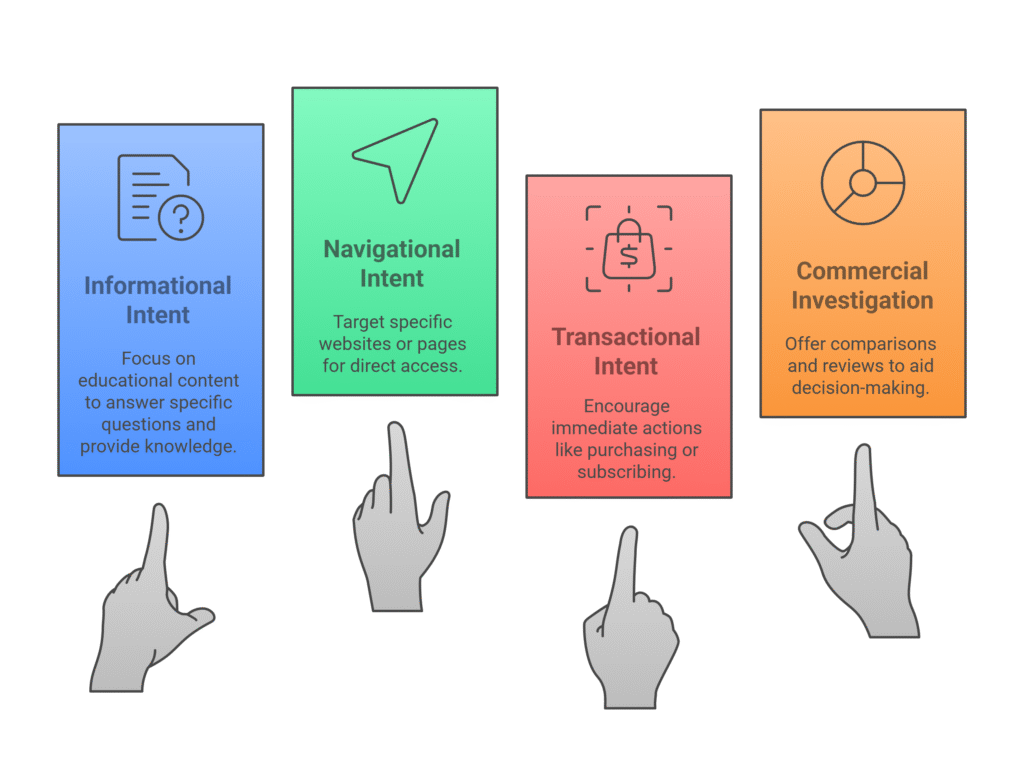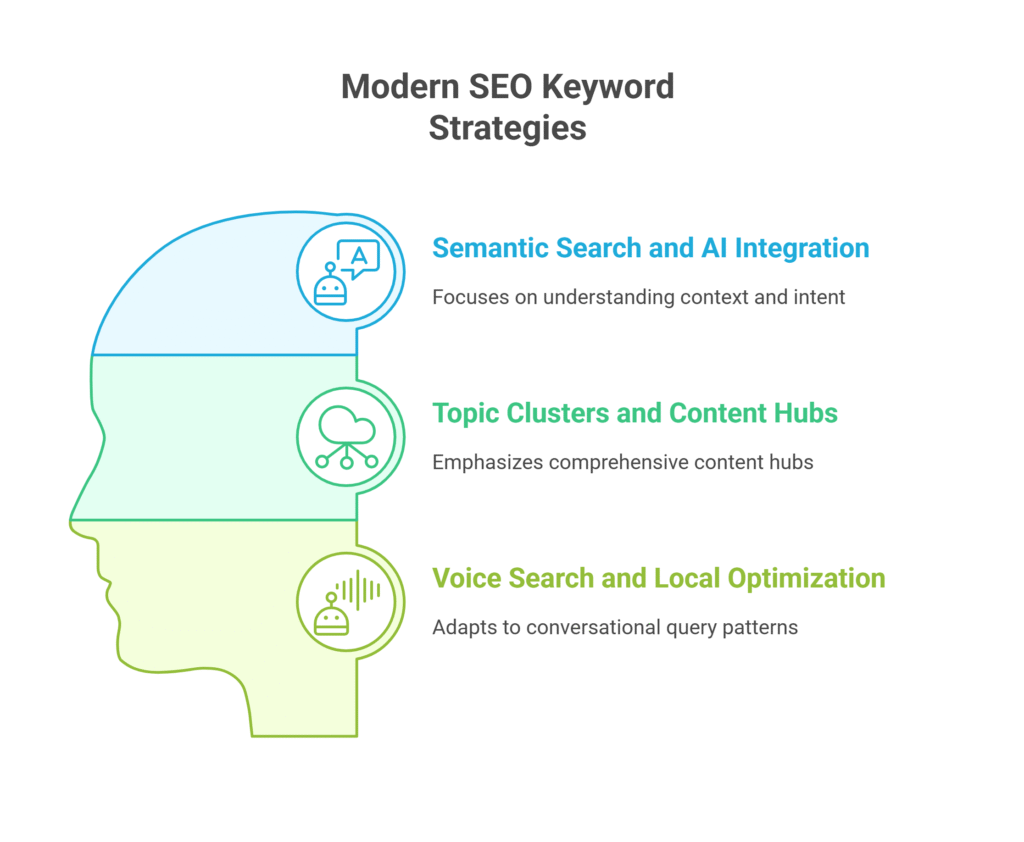Picture this: you’ve just crafted the most comprehensive blog post about running shoes. It’s packed with expert insights, honest reviews, and actionable tips. But here’s the challenge—if search engines can’t understand what your content is about, how will your target audience ever discover it?
That’s precisely where keywords become your content’s navigation system. They’re the invisible connectors that bridge what people are actively searching for online with the valuable content you’ve created. Think of keywords as digital coordinates that guide both search engines and real users straight to your content.
In this comprehensive guide, you’ll master exactly what keywords are, how modern search algorithms interpret them, and most importantly, how to implement them strategically to attract qualified traffic and reach the audience actively seeking your expertise.
What Are Keywords?
Keywords are the specific words or phrases that users input into search engines when seeking information, products, or solutions. Every search query—whether it’s a single word like “pizza” or a detailed phrase like “gluten-free pizza delivery near downtown Seattle”—represents a keyword opportunity.
Over 8 billion searches are performed daily on Google alone. Each search represents a real person with a specific need, making keywords your gateway to understanding user intent.
Keywords aren’t merely random search terms—they’re behavioral insights. They reveal what people prioritize, which problems they’re encountering, and what solutions they’re actively pursuing. When you understand keywords deeply, you’re essentially accessing the collective mindset of your potential audience.
For example, when someone searches “best running shoes,” those three words become their keyword phrase. When another person searches “how to train for a marathon,” that entire phrase represents their specific keyword intent. The sophistication lies in matching your content precisely to these search intentions.
Why Search Engines Need Keywords

Imagine navigating the world’s largest library where books had no titles, categories, or organization system. That’s essentially what the internet would resemble without keyword signals.
Search engines like Google utilize keywords as contextual clues to comprehend your content’s subject matter, relevance, and quality. When you publish content about “sustainable meal prep strategies,” Google’s sophisticated algorithms analyze your keyword usage and related terms to categorize your content appropriately.
This matching process occurs through advanced AI systems including BERT and RankBrain, which can now interpret context, understand synonyms, and recognize user intent patterns. However, the foundation remains keyword relevance. When your content aligns with search queries, you significantly increase visibility chances in relevant search results.
Different Types of Keywords
Understanding keyword categories enables strategic content planning. Each type serves different purposes and requires distinct approaches:
- Short-tail keywords: Broad, general terms typically 1-2 words long, such as “fitness” or “marketing.” These attract massive search volumes—often exceeding 100,000 monthly searches—but face intense competition from established authorities. Success requires substantial domain authority and comprehensive content strategies.
- Long-tail keywords: Specific phrases containing 3+ words, like “best noise-canceling headphones for remote work” or “beginner-friendly yoga poses for back pain.” While individual search volumes are lower (typically 100-1,000 monthly searches), they’re significantly easier to rank for and attract higher-quality traffic with clear intent.
- Branded keywords: Terms including specific brand names, such as “Apple iPhone 15 Pro review” or “Nike Air Max comparison.” These can be highly valuable for product-focused content and often convert well due to existing brand awareness.
- Local keywords: Location-specific terms like “Italian restaurant downtown Portland” or “emergency plumber Dallas Texas.” Essential for local businesses and service providers targeting geographic audiences.
Understanding Keyword Intent
Keyword research extends beyond identifying what people search for—it requires understanding why they’re searching. This concept, called search intent, determines whether your content successfully satisfies user needs and achieves meaningful engagement.
The 4 Types of Search Intent

Modern SEO recognizes four distinct intent categories, each requiring tailored content approaches:
- Informational Intent: Users seek knowledge or answers to specific questions. Examples include “what are SEO keywords,” “how to change car oil,” or “benefits of intermittent fasting.” These searches require educational, comprehensive content like tutorials, guides, and explanatory articles. Content should prioritize clarity, accuracy, and thoroughness.
- Navigational Intent: Users want to reach specific websites or pages using search as navigation. Examples include “Gmail login,” “Facebook homepage,” or “Netflix customer service.” Unless you represent that specific brand, ranking for navigational terms is typically impossible and unnecessary.
- Transactional Intent: Users are ready to complete specific actions, whether purchasing, subscribing, or downloading. Keywords like “buy wireless earbuds,” “download project management software,” or “hire content writer” signal high conversion potential. Content should include clear calls-to-action, product comparisons, and decision-making support.
- Commercial Investigation: Users research products or services before making decisions. Terms like “best project management tools,” “iPhone vs Samsung comparison,” or “top marketing agencies” indicate evaluation-stage intent. Content should provide detailed comparisons, reviews, and buying guides.
Successful content aligns format and messaging with searcher intent. When someone searches “how to start a blog” (informational), they expect step-by-step guidance, not immediate hosting sales pitches. However, “best blogging platforms for beginners” (commercial investigation) suggests readiness for platform recommendations and comparisons.
How to Find The Right Keywords
Strategic keyword research removes guesswork from content planning. Professional-grade tools provide real search data, competition analysis, and keyword suggestions that manual brainstorming cannot match.
Essential Keyword Research Tools
These tools form the foundation of effective keyword research, ranging from free options to professional-grade platforms:
- Google Keyword Planner: Google’s free tool provides official search volume data, competition levels, and keyword suggestions directly from the source. While interface design appears basic, data accuracy is unmatched for foundational research.
- Ubersuggest: Neil Patel’s comprehensive tool balances features with affordability. Free version includes keyword suggestions, search volumes, and content ideas. Paid plans offer competitive analysis and rank tracking.
- Ahrefs Keywords Explorer: Industry-leading tool providing extensive keyword databases, difficulty scores, and competitor analysis. Ahrefs excels at revealing competitor keyword strategies and identifying content gaps.
- SEMrush Keyword Magic Tool: Professional platform excellent for competitive research and keyword clustering. SEMrush shows exactly which keywords drive competitor traffic.
- AnswerThePublic: Unique visualization tool showing question-based searches and keyword modifiers. Perfect for discovering long-tail opportunities and understanding specific user questions around topics.
Keyword Research in 5 Strategic Steps
This systematic approach works effectively whether using free tools or premium platforms:
- Identify core topics relevant to your audience: List 5-10 broad themes your target audience cares about. For fitness content, topics might include “weight loss,” “strength training,” “nutrition planning,” and “recovery techniques.”
- Generate keyword ideas using research tools: Input core topics into your chosen tool to discover hundreds of related keyword suggestions. Look for recurring patterns, common questions, and specific problems users want solved.
- Analyze critical metrics: Evaluate search volume (monthly searches), keyword difficulty (competition level), and cost-per-click data (commercial value indicator). Target keywords with adequate search volume but manageable competition for your domain authority level.
- Assess search intent alignment: Ensure selected keywords match your content goals and audience needs. High-volume keywords mean nothing if they don’t align with your expertise or user expectations.
- Prioritize based on opportunity and relevance: Create a ranked list considering search volume, competition, relevance to your audience, and content creation feasibility. Focus on keywords where you can provide genuine value and expertise.
How to Use Keywords the Right Way
Effective keyword implementation requires strategic placement and natural integration. Modern search algorithms prioritize user experience, meaning keyword optimization must enhance content quality rather than compromise it.
Strategic Keyword Placement
These locations receive maximum attention from search engine algorithms:
- Title Tag (Meta Title): Most critical location for primary keywords. Appears as clickable headlines in search results, requiring keyword inclusion while maintaining compelling copy. Keep under 60 characters to prevent truncation.
- Meta Description: While not directly impacting rankings, influences click-through rates significantly. Include primary keywords naturally within compelling copy that encourages clicks. Optimal length: 150-160 characters.
- Header Tags (H1, H2, H3): Main heading (H1) should include primary keywords, while subheadings (H2, H3) accommodate related keywords and variations. This structure helps both search engines and users understand content organization.
- URL Structure: Clean, descriptive URLs including primary keywords improve both SEO and user experience. Use “yoursite.com/best-project-management-tools” instead of “yoursite.com/blog-post-12345.”
- Opening Paragraph: Include primary keywords within the first 100 words while maintaining natural flow and readability. Search engines pay special attention to content introductions.
- Image Alt Text: Describe images accurately while incorporating relevant keywords when appropriate. This improves accessibility and can drive traffic from image search results.
Best Practices for Natural Keyword Integration
Modern SEO success requires balancing optimization with user experience:
- Focus on 1-2 primary keywords per page: Avoid keyword dilution by targeting specific terms rather than attempting to rank for everything simultaneously. This maintains content focus and improves optimization effectiveness.
- Utilize semantic variations and synonyms: Google’s AI understands that “digital marketing,” “online marketing,” and “internet marketing” represent related concepts. Use natural variations instead of repetitive exact-match phrases.
- Prioritize value creation over keyword density: Write primarily for human readers while incorporating keywords naturally. If content provides genuine value, search engines will recognize and reward relevance.
- Maintain 1-2% keyword density: Primary keywords should appear approximately 1-2 times per 100 words. However, prioritize natural integration over mathematical precision.
- Avoid keyword stuffing completely: Search algorithms specifically penalize unnatural keyword repetition. Content should sound conversational and helpful, not robotic or manipulative.
Modern SEO: Beyond Traditional Keywords

Search engine optimization has evolved significantly beyond simple keyword matching. Understanding these developments ensures your strategy remains effective as algorithms become increasingly sophisticated.
Semantic Search and AI Integration
Google’s advanced AI systems, including BERT, RankBrain, and the recent MUM (Multitask Unified Model), now understand context, intent, and meaning rather than just matching literal keywords.
Google’s BERT update affects 10% of all search queries, according to Google’s official announcement. This represents millions of daily searches where context and intent matter more than exact keyword matches.
Semantic search means Google understands that “how to fix a leaky faucet” and “repairing dripping kitchen tap” address identical user needs, even with different keywords. This advancement requires comprehensive, naturally-written content that thoroughly addresses topics rather than targeting isolated keywords.
Practical implications include:
- Writing conversationally using language your audience naturally uses
- Covering topics comprehensively from multiple angles
- Answering related questions users might have
- Focusing on topic authority rather than keyword density
Topic Clusters and Content Hubs
Modern SEO strategy emphasizes topic clusters—comprehensive content hubs covering entire subject areas rather than individual keywords. This approach aligns with how search engines evaluate expertise and authority.
Instead of creating separate pages for “SEO tools,” “free SEO tools,” “best SEO tools,” and “SEO tools for beginners,” develop a strategic content hub:
- Pillar Content: Comprehensive “Complete Guide to SEO Tools” covering the entire topic
- Cluster Content: Specific subtopic pages like “Best Free SEO Tools for Small Businesses,” “Technical SEO Audit Tools,” and “Keyword Research Tool Comparison”
- Strategic Linking: Internal links connecting all related content, demonstrating topical expertise
This strategy helps establish topical authority while serving user information needs more effectively.
Voice Search and Local Optimization
Voice search adoption continues growing, requiring adaptation to conversational query patterns. Voice searches tend to be longer, more specific, and often include location modifiers.
27% of adults use voice search on mobile devices, according to BrightLocal’s Voice Search Study. Voice queries often include natural language patterns like “Where can I find…” or “What’s the best way to…”
Optimize for voice search by incorporating natural speech patterns and question-based keywords into your content strategy.
Advanced Keyword Strategies That Drive Results
These sophisticated approaches can provide significant competitive advantages when implemented strategically.
Competitor Keyword Gap Analysis
Identify opportunities by analyzing competitor keyword strategies. This reveals proven keywords you might be missing while showing content gaps in your market.
Using tools like Ahrefs or SEMrush, analyze competitor domains to discover:
- High-traffic keywords competitors rank for that you don’t target
- Content topics generating significant organic traffic
- Keyword difficulty levels for realistic targeting opportunities
- Seasonal trends and content timing strategies
Question-Based Keyword Strategy
Target specific questions your audience asks rather than just topic-based keywords. Question keywords often have lower competition and higher conversion potential.
Use tools like AnswerThePublic and “People Also Ask” sections to find question variations like:
- “How to choose email marketing software for small business”
- “What features should small business email marketing include”
- “Which email marketing platform is most affordable”
- “How much does email marketing software cost for small business”
These question-based keywords naturally lead to helpful, conversion-focused content that directly addresses user needs.
Measuring Keyword Success: Essential Metrics
Tracking the right metrics ensures your keyword strategy delivers measurable business results rather than just vanity statistics.
Critical Performance Indicators
- Organic Traffic Growth: Monitor total organic search visitors and traffic trends over time using Google Analytics. Look for consistent month-over-month increases rather than short-term spikes.
- Keyword Rankings: Track positions for target keywords using Google Search Console or dedicated rank tracking tools. Focus on top 10 rankings, as 75% of users never scroll past the first page.
- Click-Through Rates (CTR): Monitor how often people click your results when they appear in search. Low CTR indicates titles and descriptions need optimization even if rankings are strong.
- Conversion Rates: Track how organic traffic converts compared to other channels. High-intent keywords should typically convert better than broad, informational terms.
- Page Engagement: Monitor time on page, bounce rate, and pages per session for organic traffic. Strong engagement signals content quality and relevance to search engines.
Essential Tracking Tools
Google Search Console: Free, essential tool showing which keywords drive traffic, current rankings, and click-through rates. Set up immediately if you haven’t already—it’s foundational for SEO measurement.
Google Analytics 4: Track organic traffic behavior, conversion paths, and engagement metrics. Understanding what happens after people find your site is crucial for optimization.
Rank Tracking Tools: Platforms like Ahrefs, SEMrush, or SERPWatcher provide detailed ranking monitoring and competitor comparison data for comprehensive performance analysis.
Common Keyword Mistakes to Avoid
Understanding these frequent pitfalls helps prevent strategy setbacks and wasted effort.
Keyword Cannibalization
Multiple pages targeting identical keywords compete against each other rather than supporting overall site authority. This confuses search engines and dilutes ranking potential.
Solution: Conduct content audits to identify cannibalization issues. Either consolidate competing pages into comprehensive resources or differentiate them with more specific keyword variations.
Ignoring Search Intent
Targeting keywords without understanding user intent leads to content that ranks poorly or attracts irrelevant traffic that doesn’t convert.
Solution: Always analyze current top-ranking pages for target keywords. What content format works? What questions are being answered? Match your approach to proven successful patterns.
Targeting Unrealistic Keywords
Pursuing highly competitive keywords without sufficient domain authority wastes time and resources that could be invested in achievable opportunities.
Solution: Start with lower-competition, long-tail keywords to build authority gradually. Success with easier keywords provides foundation for targeting more competitive terms later.
Conclusion
Keywords remain the foundation of effective SEO, but success requires understanding modern search engine sophistication and user expectations. Today’s winning approach combines strategic keyword research with genuine value creation and user-focused content development.
The most important step is simply beginning. Don’t wait for perfect keyword research or comprehensive SEO knowledge—choose valuable content to create, research relevant keywords using the strategies outlined here, and publish something genuinely helpful to your audience.
Your target audience is actively searching for solutions, information, and expertise you can provide. Keywords are the bridge connecting your valuable content with people who need it most. Build that bridge strategically, and you’ll create sustainable organic traffic growth that benefits everyone involved.


